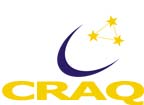2023 | 2022 | 2021 | 2020 | 2019 | 2018 | 2017 | 2016 | 2015 | 2014 | 2013 | 2012 | 2011 | 2010 | 2009 | 2008 | 2007
| The Université de Montréal participates to the moving of a 1m professional telescope to Burkina Faso. |
| 2009-11-03 | |
An international team, composed of researchers of the CRAQ (Physics Department of the Université de Montréal - UdeM), of the Observatoire Astronomique de Marseille Provence, and of the Université de Ouagadougou (UdeO, Burkina Faso), just packed for shipping to Burkina Faso the Marly telescope, previously located at the European Southern Observatory (La Silla, Chila).The telescope will be re-assembled next year at the summit of Mont Djaogari in Burkina Faso. The team was composed of Professor Claude Carignan and Guillaume Provencher (machine shop technician), both from the Physics department of the UdeM, as well as Daniel Lacroix and Claude Figuiere, retired engineers from the Observatoire de Haute-Provence (France) and of Pierre Sanon and Adama Ouedraogo, technicians at the UdeO. This enterprise is part of the entente signed in September 2008 between the UdeM, the Université de Provence and the UdeO. In the recent internationalisation strategy of the UdeM, the UdeO is the priority establishment in Africa for international development projects. In addition to astrophysics, the UdeM also has important collaboration in demography (funded by the Bill and Melinda Gates foundation) and in Educative Sciences (distance learning funded by the Agence Universitaire de la Francophonie) The collaboration in the domain of astrophysics was developed by Claude Carignan and the Professor Jean Koulidiati, former professor of the Laboratoire de Physique et Chimie de l'Environnement (France) and now president of the UdeO. The astrophysics program, inspired by that of the UdeM, was accepted by the scientific committee of the UdeO in the Fall 2007 and the first undergraduate class (B.Sc) was lectured by Claude Carignan to a hundred students. In late 2007, a teaching observatory (ODAUO), equipped with a 25 cm telescope and a CCD detector was erected by Luc Turbide, IT technician for the astronomy group at the UdeM. The first M.Sc. course was given to 20 students in the beginning of 2009. Two students from Burkina Faso are currently pursuing their graduate studies (MSc. and PhD respectively) at the UdeM Physics Department and will take over the astronomy program at UdeO at the end of their studies. With the help of the ESO Staff, the team took two weeks to completely take apart the 10-tons telescope, and place it in a shipping container. On October 31st, it left Valparaiso in Chile onboard the MSC Cordoba, should arrive in Tema (Ghana) on December 10th, and a few days later in Ouagadougou. The telescope will then be refurbished and put together on the summit of Mont Djaogari once the proper installations (road, observatory, residence and solar power plants) are completed. The construction should be done by mid-2011. In accordance with the agreement signed between the three universities, the available observing time will be shared as follows: 25% for UdeM, 25% for the Université de Provence, 25% for the UdeO, and 25% for the international community. The collaborations projects between the three universities and the thesis projects for graduate students will have the priority for the allocation of observing time. The telescope will be equipped with cutting-edge instrumentation, including the ultra sensitive detector recently developed by the LAE (Forum, Sept 28th 2009). One of the first scientific projects will be to map ionized hydrogen in the part of the Milky Way visible from the northern hemisphere. Therefore, after 2011, the astronomers of the UdeM will have access not only to the 1.6m telescope at the Observatoire du Mont-Mégantic but also to the 1m telescope at the Mont Djaogari, where meteorological data over the past 10 years predict more than 300 clear nights per year.
Informations : |
This web site is for Microsoft Internet Explorer and Firefox.
